As sunset approaches, an accordionist entertains some ice-cream-eating fans with the "Chicken Dance" on the Tiki Bar deck at Oriental Marina & Inn on Raccoon Creek.
These young ladies requested the "Chicken Dance," then danced about 5 seconds before returning to their ice cream (from "The Bean," across the street)... they kept moving to the beat, and seemed pleased with the song, but doing the Chicken Dance does require clapping one's hands too often to be compatible with eating ice-cream.
The Tiki Bar deck is a great place to watch the sun setting over Raccoon Creek and the commercial trawlers tied up at Garland Fulcher Seafood. I'll feature a sunset shot from the Tiki deck sometime soon.
Aliens staying in the hotel or on boats at the marina mix with a good crowd of local regulars, and on summer weekends there are usually a bunch of kids and dogs playing on the grass by the visiting sail and power pleasure boats tied up at the Oriental Marina & Inn slips.
Sometimes the older kids play bocce on the lawn, and on most summer weekend nights there is a live band on the deck.
-30-
Attention on deck! Daily photos are no longer being updated on The Dinghy Dock...
Visit my other blog,
"ORIENTAL DAILY PHOTO"
for my almost daily photos of Oriental/Pamlico County/ Local Waterways...
Thanks for coming aboard!
-Capt. Ben
Sunday, August 31, 2008
8.31- "Chicken Dance" and Ice Cream on the Tiki Deck
Saturday, August 30, 2008
8.30- Stuck in the Mud
A 40' Lord Nelson, the "Aurora," home port Parker, Texas, sits stuck in the mud of Oriental Harbor.
This itinerant sailboat ran aground in the soft mud of Oriental Harbor while seeking anchorage near dusk this evening.
After running aground, the sailboat captain used his dinghy to set an anchor, and unsuccessfully tried to "kedge" the boat off her ground.
Soon after the failed kedging attempt, a passing Boston Whaler with an 80 HP outboard offered to help tow the boat off... she gave it a good try for about ten minutes, but this sailboat was good and stuck as the sun was setting.
Guessing the sailboat draws 6 feet or more, probably with a full keel (she looks to be a blue-water sailer), stuck in 5.5 feet of water with the wind blowing towards even shallower water.
We'll see if and how she makes it out of the mud tomorrow.
[8.31 Addendum - She did make it out the next morning by motoring back the way she came in (the wind-tide had also risen a half foot or so overnight.)Hopefully, we will also find out why there is a faux goose standing on the bowsprit!
After a day out sailing, she came back and anchored in a deeper part of the harbor. I sailed out in the Bauer dinghy, and met the boat's captain.
She is the "Aurora," and has been the home to Captain Ted and his wife since they sailed from Port Aransas, TX last November. The couple expect to winter over in the Chesapeake Bay and then... maybe bahamas, maybe who knows?
The "Aurora" is a 39 foot (deck length... bow sprit adds another 9 feet) "Lord Nelson" blue water sailboat built in Tawain. Capt. Ted explained a bit of the history of the "Lord Nelsons," but about all I retained was that it was essentially an adaptation of an earlier design, the "Hans Christian."]
[8.31 Addendum - Capt. Ted explained that the goose is the boat's "guard-goose," whose so-far-successful mission is to keep elephants off of the boat.]-30-
Friday, August 29, 2008
8.29- Masses of Menhaden
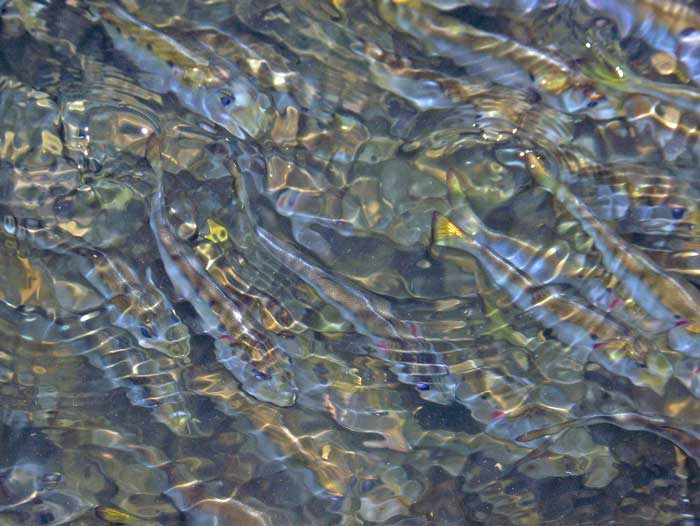
Menhaden (a type of fish) schooling next to the Hodges Street causeway over Raccoon Creek (next to Town Dock).
The menhaden invasion continues... Untold millions of menhaden minnows have thronged area creeks this summer, thriving in their estuaries.
The enormous schools of menhaden minnows create "boiling" effects along creek shores and docks. Especially on calm days, when the wind is not creating waves, the water everywhere seems to shimmer as the never-ending schools of tightly packed menhaden create surface turbulence.
I did take a video of the menhaden, since the still picture does not quite capture their frenetic nature:
All I Know About Menhaden (at least I think it's interesting):
Local crabbers (recreational and commercial) and recreational fishers use menhaden for bait. It is extremely easy to catch many hundreds of the 1 to 2 inch minnows simply by tossing a cast net from the shore.
People don't eat menhaden in their natural fish form, but commercial menhaden fisheries produce commercially successful proteins and oils extracted from the fish, as I learned last summer when I visited Reedville, Virginia.
Reedville, VA is home to the only menhaden fishing fleet on the Atlantic Ocean, and to a large processing plant that turns hundreds of millions of pounds of menhaden into fishmeal and oil for use in a wide variety of products.
Like Oriental, Reedville is a small town dominated by a large commercial fishing fleet. Unlike the Oriental fleet, which concentrates on shrimping and some scalloping, the Reedville fleet is 100% dedicated to menhaden, which it harvests in enormous quantities.
While there, I spent a couple of hours at the Reedville Fisherman's Museum, which is essentially a propaganda outlet for the commercial menhaden industry (though they do also have an impressive floating collection of wooden boats, including one of about 30 surviving Chesapeake Bay "Skipjack" sailing oyster boats, which the museum continues to operate for charters and tours... all in all, well worth visiting.)
When you enter the museum, the docent immediately shunts you into a small room to watch a ten minute video about commercial menhaden fishing (the museum has now posted the video on YouTube, so I have embedded it below in this post)
Once properly indoctrinated, you are allowed wander the halls of the museum, which feature a pretty amazing photographic history of the industry in action, as well as scale models depicting key technological developments that have led to today's frighteningly large catches of the fish.
The modern menhaden fleet consists of about 10 "steamer" ships, each of which carries two smaller "purse-seine boats"...
When one of the fleet's associated airplanes spots one of the gigantic menhaden schools from the air, the steamer heads that way and launches the purse seine boats.
The purse seine boats each take one end of a 1500-foot purse seine net and encircle a portion of the school then close the bottom of the net, trapping the fish... The area within the net may only be a tiny piece of the overall school, but will result in a catch of up to 300,000 menhaden.
The fish are then pumped out of the nets by the steamers (using giant vacuum tubes that are lowered into the trapped mass.) When their holds are filled, the purse seine boats are brought back aboard and the steamers head back to the processing plant at Reedville.
At the plant, the fish is "cooked" and pressed, separating it into "liquor" (water and oil) and "cake" (solid fish meal). If you are ever in Reedville, you will immediately know if the plant is cooking, as an odor-you-would-not-believe pervades the air downwind of the plant... make sure to anchor or tie up on the windward side of the stacks! (Crazy Crab Restaurant and Marina is recommended, so long as the wind is not out of the south)
The dry meal is used, among other things, as a protein for livestock and pet foods. (take a deep whiff of a can of fish food flakes, or while in the cat food aisle at Pet Smart and you will have a small clue as to the odor that emanates from the processing plant)
The oil is mostly exported to Europe for use as cooking oil/margarine/shortening for human foods (as the Reedville Fisherman's Museum film points out, if you've ever been to France and enjoyed their croissants, likely cooked with menhaden oil), but because the American market has so far not embraced menhaden as a food oil it is instead used here for industrial products like paint and cosmetics.
If you only watch the Reedville Museum's film (embedded below) you might think, as the narrator asserts, that it is indeed:
"the perfect commercial fish... fishermen don't value them except as bait [not good eating, plus they are toothless phytoplankton eaters not catchable with hook and line so sports fishers don't care about them]... they are plentiful, self-renewing, usable in a variety of ways and catchable in large quantities without accidentally killing other valuable fish that people want to eat or catch for sport."
(Video from the Reedville Fisherman's Museum, Reedville, VA)
Some conservationists and sports fishers, however, complain that because menhaden are a significant link between plankton and larger predatory marine and avian life, the large-scale removal of their protein from the ecosystem can only have damaging effects on predator populations such as striped bass, bluefish, mackerel, flounder, tuna, drum , sharks, egrets, ospreys, seagulls, northern gannets, pelicans, herons, etc... Some allege that commercial menhaden fishing has even led or contributed to an alarming increase in appearances of lesion-causing mycobacteriosis and Pfiesteria among menhaden predators such as bass and rockfish.
The U.S. Dept. of Commerce's National Oceanic and Atmospheric Administration projects that this year the 10 steamers of the Reedville-based Atlantic menhaden fleet will bring in close to 200 Million Tons of menhaden! (see NOAA report)
According to NOAA, the combined Gulf and Atlantic menhaden fleets landed 454,000 metric tons (1.39 BILLION pounds) of the fish last year.
I won't bother linking to the multitude of sources discussing the debate over whether menhaden are being over-fished to the detriment of other species (and whether that is even possible)... if you are interested, you can google and find tons of discussion on the subject, most of which appears in the form of defensive discussions from the commercial fishing interests.
If you want to see more video of menhaden fishing in action, however, I do recommend this YouTube video, apparently made by a commercial menhaden fisher (and oddly accompanied by Dire Straits' "Sultans of Swing")
-30-
8.29- Skywatch Friday - July 8 storm retrospective
(For best results, click on "->" to start slide show, then click Pause and use arrows to advance slide by slide)
(For best results, click on "->" to start slide show, then click Pause and use arrows to advance slide by slide)
SkywatchFriday special retrospective report. I never did post these pics from July 8, but the rainstorms on Wednesday reminded me I had these pictures.
The captions tell the story.
But I do have a question for my fellow Skywatch Friday visitors, and would love to hear your inputs, perspectives:
I am used to posting photos the day I take them... in fact I have just started participating in City Daily Photo on my other blog, Oriental Daily Photo. The sky today, however, was quite boring, and I didn't really have any good sky pics from this week, even. So, my question is:
Is it more appropriate for me to post Skywatch Friday pictures taken on the each current Friday? Or at least from the week preceding each current Friday?I am very interested in hearing the views on this issue from my more experienced (more experienced than I, that is... this is my second SWF entry) Skywatch Friday participants on this one! Thanks in advance for your thoughts!
Or does it make more sense to do as I have done today, that is post pictures I have taken at some point of interesting skies, regardless of when they were taken?
-30-
See more views of the heavens from around the globe at Skywatch Friday.
Thursday, August 28, 2008
8.28- Princess Sharpie 22 on Smith's Creek
A 22' Princess Sharpie cat-ketch sails up Smith's Creek as dusk approaches.
This boat was designed by naval architect Graham Byrnes, whose B&B Yacht Designs is located in nearby Vandemere, NC, on the Bay River.
Check out B&B's Princess Sharpie 22 page, for more info about this sweet vessel, including photos of the construction process & interior. You can order the plans for this boat at the B&B site for about $200.
B&B dinghies and small sailboats are understandably popular here in eastern NC, and most are designed specifically for eastern NC's inland and coastal waters.
-30-
Wednesday, August 27, 2008
8.27- Respite from the rain
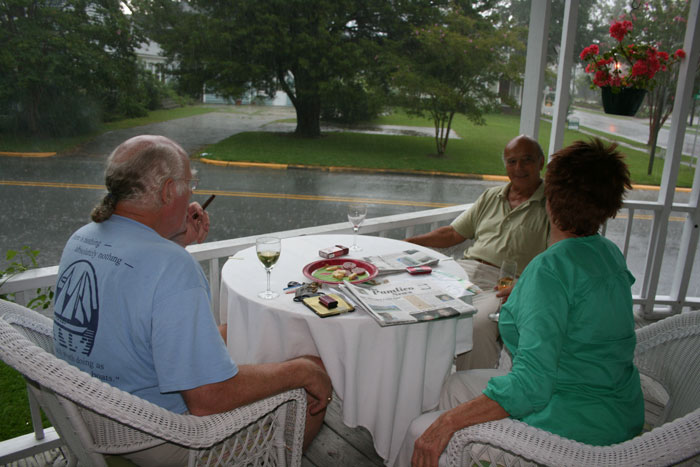
Captain Roy (nearest to the street) holds court on the porch of The Captain's Quarters Bed and Breakfast on a rainy day here in Oriental.
Capt. Roy, owner of The Captain's Quarters B&B hosts some friends for wine, cigars, antipasti and conversation on the porch on Broad St. (Hwy. 55) as afternoon rains pass over Oriental. Today's new edition of the weekly "Pamlico News" newspaper rests on the table.
Broad St. is the main thoroughfare through "downtown" Oriental, so while sitting on this porch (at the intersection of Church St.) one can see everyone in town driving, biking or walking by, and many folks wave to Capt. Roy and anyone who happens to be on the porch.
Even a day of rain and thunder doesn't stop the regular appearance of Capt. Roy and guests on the porch... a great place to get out of the rain and enjoy some excellent company... or on sunny days, to get out of the sun and do the same.
-30-
Tuesday, August 26, 2008
8.26- Mink on the breakwater
This is one of the two young minks who regularly hunt for crabs and other meals in the breakwater along the South Avenue waterfront (next to Lou-Mac Park) here in Oriental.
The minks patrol this breakwater several times a day... they usually crawl under the rocks as much as possible, but occasionally must break out into the open to get where they need to go. When they know someone is watching, they won't sit still in the open, but will zip from one hidey-hole to the next with surprising speed.
I know I have featured the "Lou-Mac Minks" before (see post of 7.16.08), but they are just too darn cute. I can't swear I won't feature them again in the future.
-30-
Monday, August 25, 2008
8.25- Seafood Straight from the Boat

Boxes of "Fresh Seafood," each containing a bushel or thereabouts of Shrimp from Pamlico Sound, await pickup on the loading dock of a local fish-house (Garland Fulcher Seafood).
One of the commercial shrimp trawlers (I think it is the "Captain Jeff") peeks through the passageway while tied up at the fish-house dock.
-30-
Sunday, August 24, 2008
8.24- Sunday Night Shrimping
Trails of light left by small boats shrimping in Oriental Harbor.
Sunday through Friday is shrimping time in NC, and Oriental Harbor is no exception.
There is a shrimping curfew from Friday midnight to Sunday noon, which is why there are dozens of large commercial trawlers docked in the harbor on the weekend (as seen in the banner photo at the top of this blog), and almost none during the week... Local lore has it that the Sunday noon ending time is so commercial shrimping crews can go to church, which is a bit of a laugh...
While most of the large commercial trawlers that operate out of Oriental (featured in the header photo at the top of this blog) are out shrimping in Pamlico Sound, Oriental Harbor hosts many local shrimpers in much smaller boats (see my post of July 22 for a daytime picture of "Play'n Hookey," a vessel similar to the ones leaving the light trails in today's pictures).
The small boat shrimpers circle around in a complex dance around Oriental Harbor and the channel into the Neuse River, towing their nets and periodically stopping to haul their nets and separate their catch... shrimp are kept, while untold hordes of mullet, menhaden and other minnows so prolific in the local estuaries are unceremoniously dumped overboard (usually dead or dying).
Sunday night sees the heaviest small shrimper traffic of the week, with a dozen to twenty or so boats working the waters.
The boats putter around in almost complete darkness, most of the time with only their navigational lights on... Spotlights are used intermittently to illuminate obstacles (shoreline, other shrimping boats, anchored sailboats, channel markers, bridge piers, and the buoys that float above the ends of each boat's net), and deck lights turn on when it is time to haul in the full nets and separate the catch. All these lights contributed to today's photos.
The soft glow in the sky on the right side of today's photo comes from the lights of Beaufort and Morehead City, about 20 miles to the South. You can barely see the glow at night with the naked eye, but it becomes more pronounce in this time exposure photos.
Some of the boats have music playing on board; tonight I heard some AC/DC and Led Zeppelin as the boats passed near the bridge from which I shot these pictures.
-30-
Saturday, August 23, 2008
8.23- Healeys on Hodges
About a dozen Austin-Healeys and other British sports cars/roadsters parked on Hodges Street between Town Dock and The Bean coffee shop today as the Austin-Healey Club of America held its annual "ice cream social."
Owners (and some passengers) met for ice cream at Oriental's premiere coffee and ice cream shop, "The Bean," this year.
Most of the Austin-Healeys were "3000 MK" models (including both cars appearing in today's photo), though there was at least one "bugeye" Sprite as well. Also in the mix were several MGs, a Lotus Mark 7 (getting a "race car" start with the help of friends in today's slide show) and a Jaguar XKE.
For more photos of today's AH meet, see The Pamlico News' photo essay of the event.
[8.25 Addendum: also for more photos of the meet, see TownDock.Net's page of photos]
-30-
Friday, August 22, 2008
8.22- Dinghy Sailing Rig version X-3
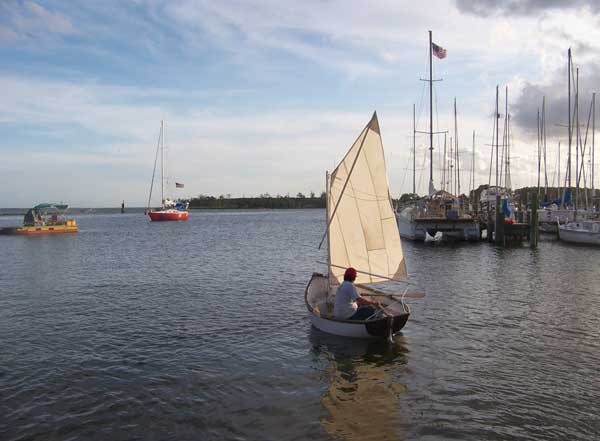
Here I am testing out the third version of the sailing rig my dad (Capt. Dave) and I have been working on for the past couple of months. Capt. Dave took this picture from the Dinghy Dock as I headed into the harbor... I eventually rounded the breakwater for some sailing in a good 12 to 15 knot easterly winds on the Neuse River.
Version X-3 features a boom, which neither of the earlier versions had. This is the same sail as version X-2, but we have rigged the former sprit spar from X-1 as a boom to see if it helps the sail trim at all, hopefully to increase windward ability and perhaps add a little speed (after testing X-1 we made a larger sail for X-2, which required building a longer sprit, so the sprit from X-1 was abandoned... you can see it is a tad too long for a boom on X-3, sticking out in front of the mast, but this was a concept test, so we did not cut it shorter yet.)
The boom definitely helped keep the sail from flailing about so much when luffing, but it also meant one sure as hell better duck when tacking and especially when jibbing, cuz that stiff boom is a lot less forgiving than the sail on its own when it comes to contacting one's head.
I reached a good (and consistant) 2 to 2.5 knots close hauled into some good 1 to 1.5 foot waves out in the Neuse... Seems to be an improvement in that the waves did not appreciably slow the dinghy down, as they did when sailing X-2 on the same point of sail. Of course, some of that can be marked up to the fact that during the last two weeks I have learned a bit about using my body to "work" windward waves by watching the dinghy racing events in Qingdao, China, on NBC's web-casts of the Olympic sailing events.
On broad reach and running points-of-sail, I still only hit about 4.0 knots (same as with X-2), which is probably close to hull speed for this Bauer Classic 10 dinghy.
Not sure if she is pointing higher on windward reaches... the wind was a bit high today, as were the waves, so it probably was not a good day to compare handling with my experiences with X-2.
More testing is in order. If we decide to incorporate a boom on X-4, we will need to rethink how to rig it... we really just jury-rigged the boom for these tests with available hardware, and it was awkward to handle.
Also, as it was rigged today, the boom fouled the sail on the starboard tack (we could switch the boom to the other side of the sail, but then it would just foul the sail on the port tack), and it fouled it right in the belly that we worked so hard to form on this sail (the sail on X-1 was basically flat, and would not go to weather at all, so we added broadseaming on the second sail to create a lot more sail draft, which helped a lot in windward ability.) Now we need to figure out how to rig the boom so it does not interfere with the draft on windward points of sail.
All in all, though, I think the boom will prove to be a benefit, though it does complicate what started as a very simple rig. Oh, well, simple isn't all that great if you can't get where you want to go.
-30-
Thursday, August 21, 2008
8.21- "Nana" the "Nantascot" figurehead
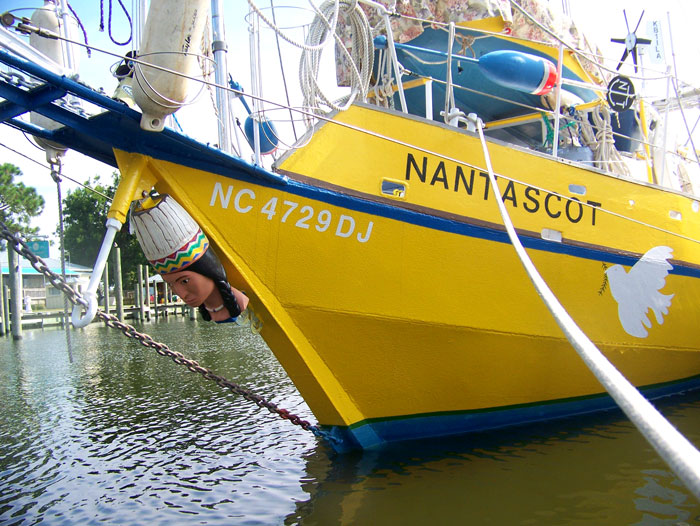
"Nantascot" pulled into the Town Dock today. She is certainly a colorful boat, and the only boat I have ever seen in Oriental with an actual figurehead. The carved figurehead is named "Nana."
I found a blog site for the boat, but it appears the Captain set up the site and has not done much with it, though it does have a number of photos and a lot of information about the vessel... See the "Sailboat Nantascot" site here.
According to the website:
"Nantascot is a 28’9” Bruce Roberts steel hull cutter. [Note: elsewhere on his website, the Captain describes Nantascot as "A 28 foot R. Bruce Roberts-Goodson, designed Spray, that the owner had built in his garden."]
"Originally launched in 1992, but never sailed by her first owner. This turned out to be a wise choice, judging by condition of the systems and the defects in the hull. The vessel was redesigned and rebuilt complexly by her new owners David Moore and Virginia Wilcox. During the five and a half year process approximately 2 tons of steel, fittings and equipment were added. The most obvious design changes were the addition of a pilot house and an aft extension."
The Captain's web site gives a detailed (with several drawings/plans) account of how he re-built the steering system with old bicycle parts he found at the dump... he purposely used parts that would be easy to replace anywhere in the world without having to special-order and wait forever.
Also, the Captain built an "unsinkable survival raft" that sits on the forward deck and required a new foresail design to keep the sail from catching on the raft. The blue hull and yellow side of the raft is visible in this picture, though the raft was covered in what looked like a floral-print curtain.
If you would like to build your own Bruce Roberts-designed sailboat (or power boat for that matter), whether wood, glass or steel, visit the Official Bruce Roberts site and order your plans today!
-30-
Wednesday, August 20, 2008
8.20- Painted Shutters
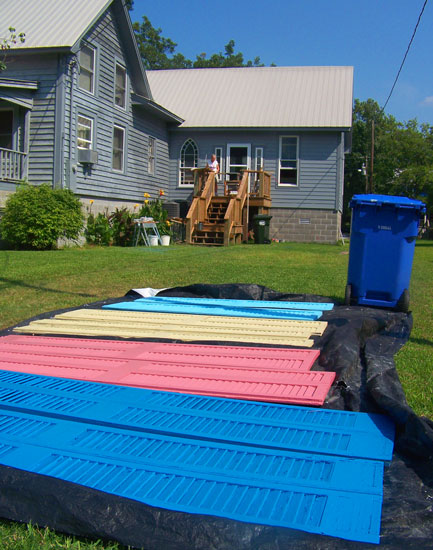
A resident of Oriental's old "Village" neighborhood cuts wood with a small table-saw on her porch while newly-painted 19th century shutters dry in the yard.
The original house is on the left, while the "wing" to which the stairs in the picture lead is a recent addition to the back of the old home. The owner has been remodeling her house for at least a couple of years, mostly on weekends and heavy on the DIY labor.
These shutters ought to make the home one of the most colorful in the village.
-30-
Tuesday, August 19, 2008
8.19- Tree Crab
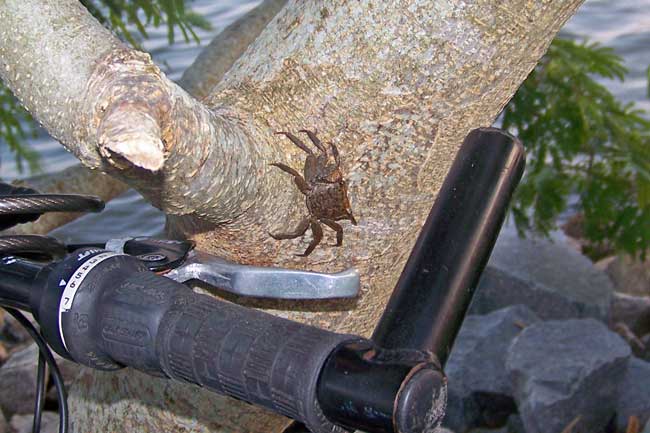
Found this shore crab clinging to the Mimosa tree next to the dinghy dock... those are the handlebars of my bicycle, which means the crab is a good 3.5 feet up the tree.
It was difficult to get a picture of it because, like a squirrel, the crab scurried around to the other side of the tree every time I moved to take a picture of it.
I have never seen one of these tiny crabs outside of the rip-rap of breakwaters, so I was quite surprised to find one climbing a tree.
See my post of July 17 for pictures of another shore crab in its' usual rip-rap environment, feeding on a marine isopod ("sea slater").
-30-
Monday, August 18, 2008
8.18- Navy Special Warfare R.I.B.'s
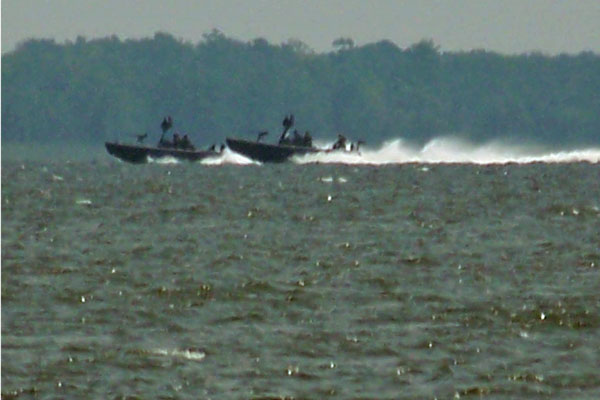
Two U.S. Navy "NSW RIB"s ("Naval Special Warfare Rigid Inflatable Boats") cruising down the Neuse River, about three miles across from Oriental's Lou-Mac Park.
According to the U.S. Navy (see NSW RIB page at NavySeals.com):
"The 11-Meter Naval Special Warfare Rigid Inflatable Boat (11M NSW RIB) is a high speed, high buoyancy, extreme weather craft with the primary mission of insertion and extraction of SEAL and other Special Operations personnel from enemy occupied beaches. The RIB hull is made of glass reinforced plastic. The 11-Meter RIB has demonstrated the ability to operate in light-loaded conditions in Sea State 6 and winds of 45 knots..."These boats carry a crew of three, plus up to an eight person SEAL team, at upwards of 45 knots. Looked like they were cruising at 40 plus knots when I took this picture. They are powered by two 470 HP Caterpillar 3126 diesel engines.
The boats feature a radar mast (the tallest structure sticking up from the boats), plus fore and aft weapons mounts, each capable of holding .50 cal., M60 or MK19 grenade launcher. I'm guessing that is either an M60 or a .50 cal. mounted forward on these two.
Periodically, Navy personnel stay in a hotel here in Oriental while they undergo training or exercises on these boats, and I have spoken with some of them at some of Oriental's watering holes in the past ... apparently, the training and exercises launch from the U.S. Coast Guard Station at Hobucken, NC (on the Intra-Coastal Waterway at Jones Bay, just north of the mouth of the Neuse River) and go shooting targets at the "BT-11 Multipurpose Electronic Target Complex" on Piney Island (on the south side of the mouth of the Neuse ... for more about BT-11, see my prior post of July 28 .)
Since Hobucken has no hotel (or watering holes) the NSW RIB crews generally stay here in Oriental during exercises, though the boats do not.
For more about the NSW RIB, check out the following links:
-30-
Sunday, August 17, 2008
Monday, August 11, 2008
8.11- Raccoon Creek Shrimp
This family spent all afternoon fishing from the Dinghy Dock today.
The kids were happy to show me the shrimp they had caught in their casting net... I was told that these are "white-tail" shrimp.
Mostly they were catching menhaden minnows with the net, and using them to bait their crab pot as well as their rods.
The youngest of the group pointed out a box of cinnamon donut-holes, explaining that she had tried to use them as bait, but they tended to fall off the hooks.
I asked what kind of fish could be caught with donut-holes... "Any fish that likes cinnamon" she explained. Well, ask a stupid question...
Dad caught a fish, which I think he said was a trout, but which I think was a Red Drum... I was really hoping the kids would start chanting "Red-rum, red-rum," but I suppose they haven't read Stephen King at their age.
The boy confidently told his dad that the catch limit for the fish was 17 inches, then, after placing the fish against a measure, he (equally confidently) insisted that he had forgotten, and the limit was actually only 14 inches, so they could keep the fish.
The dad vetoed that ruling, however... (he admitted to me he would rather catch and release all day, then go to "M&M's" Restaurant to eat fish someone else had cleaned and cooked.)
The youngest fisher was delegated the task of releasing the fish, which she did after having about a two minute conversation with it... I couldn't hear what either one was saying, but the young fisherwoman seemed pleased with whatever the fish had to say.
-30-
Sunday, August 10, 2008
8.10- Watermelon Rinds
Saturday, August 9, 2008
8.9- South River
(Skywatch Friday 8/22/08 -- I just learned about Skywatch Friday, and this is my first attempt to participate... I hope it works. Old Wom Tigley at Skywatch Friday informed me that I could participate with old photos, so I am testing with this one I took over a week ago. In the future, I will try to do one for the current week, if not actually on each Friday.)
Today I took a trip across the Neuse River to South River with a neighbor in his Mako power boat.
As we crossed the Neuse, a squall moved in over Oriental and the Neuse River behind us, coming in from the northwest...
While we were enjoying sun in South River, things were getting pretty hairy along the route back, as the storm was spreading and moving our way.
Weather can get very nasty on the Neuse in a very short period of time: many a boater and fisher has died out there in surprise squalls.
Not being in a boat built for weather, we decided to tie up amongst the branches of a fallen oak tree along the shore to see how the weather developed... as lightning and thunder started moving across the river in our general direction, we stepped ashore and as it began to rain we rigged a lean-to with a tarp, just in case we got stranded in a serious down-pour.
I took this picture from the bank, looking back towards Oriental and the threatening skies.
While we waited, we poked around the river bank looking for arrowheads and other artifacts... My neighbor is an avid hunter of fossils, shark's teeth, Native American artifacts and other found treasures... found no "keeper" arrowheads (fragments only) but did see this very old loop of chain.
While wading in the shallow water, I became surrounded by a huge school of menhaden minnows swimming upriver. I stood there for three or four minutes as they swam past me en masse, and more were still coming when I walked back to shore.
As it turned out, we only got a little sprinkle for a while, then the weather cleared enough for us to get back in the boat and head back across the Neuse River and up Green's Creek to the boat's home dock across the creek from Oriental.
-30-
See more views of the heavens from around the globe at Skywatch Friday.
Friday, August 8, 2008
8.8- Dawson's Creek Bridge at dusk
Today's pictures are from the mouth of the nearby Dawson Creek, where it enters the Neuse River.
The bridge is on the road between Oriental and Minnesott Beach, which is where one catches the ferry across the Neuse to get to Beaufort or to Havelock, where the Cherry Point Marine Corps Air Station resides.
Crabbing, shrimping and fishing are really heating up around the area the last month. Creeks and river are teeming with catches.
For my readers from outside of Pamlico County, yes, this is the "Dawson's Creek" that gave name to the TV show... The show's screenwriter, Kevin Williamson ("Scream," "I Know What You Did Last Summer"), grew up right here in Oriental, NC.
Though the "Dawson's Creek" TV show takes place somewhere on the New England coast, it is purportedly based on Williamson's experiences in and around Oriental as a youth. Coming full circle, while the TV show is supposed to take place in New England, it was mostly filmed in in Wilmington and Durham, North Carolina.
-30-
Thursday, August 7, 2008
8.7- Optimists and a Sunfish
The Optimist fleet has been busy for the past couple of months teaching kids how to sail.
The Optimist dinghies are featured in two previous posts, one of the naming ceremony and blessing of the Optimists on June 1, and then two pictures of the boats sailing, taken from shore on June 9.
Today I rode up the bridge over Smith Creek to get some better views as the Optimists launched from next to the Town kayak dock, sailed around a couple of buoys in Smith Creek, then proceeded under the bridge and out towards the Neuse river.
Today they were joined by a Sunfish (green striped sail)... from what I could hear from the bridge, the man in the Sunfish was also learning to sail, alongside the youths in the Optimists. Instructors were in the inflatable dinghies with outboard motors.
-30-
Monday, August 4, 2008
8.03- Cute Kitten Needs Home...
This adorable and playful kitten needs a permanent home. I'll post more about this kitten's background and who to contact soon...
-30-









